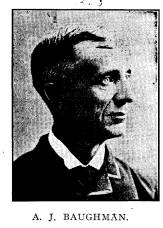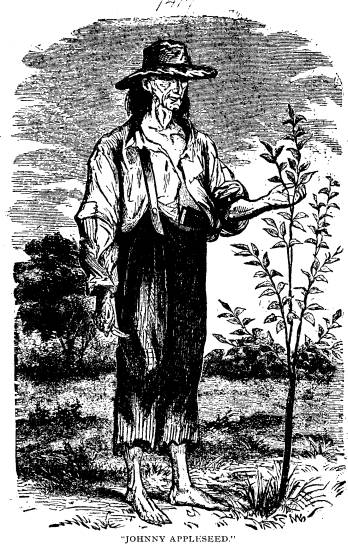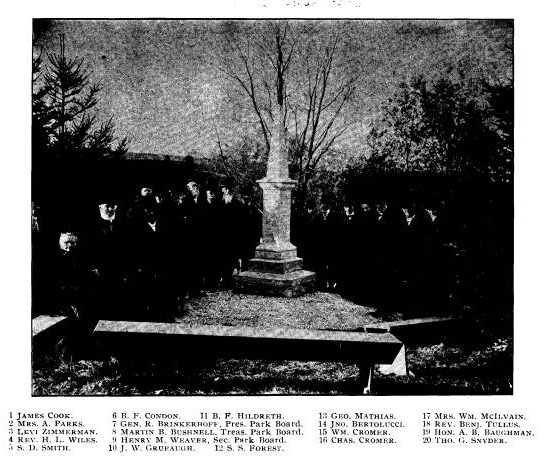Ohio History Journal
|
"Johnny Appleseed." 305
buried near what is now the city of Fort Wayne. To the end he was true to his mission of planting nurseries and sowing the seeds of medicinal herbs. To the pioneers of Ohio he was an unselfish benefactor and we are here today to aid in transmitting to coming generations our grateful memory of his deeds.
HISTORICAL SKETCH. The historical sketch of "Johnny Appleseed" was prepared and presented by Mr. A. J. Baughman, a recognized authority in the early history of Richland county. Mr. Baughman's address was as follows: John Chapman was born at Springfield, Mass., in the year 1775. Of his early life but little is known, as he was reticent |
|
|
about himself, but his half-sister, who came west at a later period, stated that Johnny had, when a boy, shown a fondness for natural scen- ery and often wandered from home in quest of plants and flowers and that he liked to listen to the birds singing and to gaze at the stars. Chapman's penchant for planting apple seeds and cultivating nur- series caused him to be called "Appleseed John," which was finally changed to "Johnny Apple- seed," and by that name he was called and known everywhere. |
|
The year Chapman came to Ohio has been variously stated, but to say it was one hundred years ago would not be far from the mark. An uncle of the late Rosella Rice lived in Jefferson county when Chapman made his first advent into Ohio, and one day saw a queer-looking craft coming down the Ohio river above Steubenville. It consisted of two canoes lashed together, and its crew was one man-an angular oddly-dressed person-and when he landed he said his name was Chapman, and that his cargo consisted of sacks of apple seeds and that he intended to plant nurseries. |
306 Ohio Arch. and His.
Society Publications.
Chapman's first nursery was planted nine
miles below Steu-
benville, up a narrow valley, from the
Ohio river, at Brilliant,
formerly called Lagrange, opposite
Wellsburg, W. Va. After
planting a number of nurseries along the
river front, he extended
his work into the interior of the
state-into Richland county-
where he made his home for many years.
Chapman was enterprising in his way and
planted nurseries
in a number of counties which required him to travel hundreds
of miles to visit and prune them yearly, as was his custom. His
usual price for a tree was "a fip
penny-bit," but if the settler
hadn't money, Johnny would either give
him credit or take old
clothes for pay. He generally located
his nurseries along
streams, planted his seeds, surrounded
the patch with a brush
fence, and when the pioneers came, Johnny had young fruit
trees ready for them. He extended his operations to the Mau-
mee country and finally into Indiana,
where the last years of his
life were spent. He revisited Richland county the last time
in
1843, and called at my father's, but as
I was only five years old
at the time I do not remember him.
My parents (in about 1827-'35) planted
two orchards with
trees they bought of Johnny, and he
often called at their house,
as he was a frequent caller at the homes of the settlers. My
grandfather, Captain James Cunningham,
settled in Richland
county in 1808, and was acquainted with Johnny
for many years,
and I often heard him tell, in his
Irish-witty way, many amusing
anecdotes and incidents of Johnny's life
and of his peculiar and
eccentric ways.
Johnny was fairly educated, well read
and was polite and
attentive in manner and was chaste in
conversation. His face
was pleasant in expression, and he was
kind and generous in
disposition. His nature was a deeply
religious one, and his life
was blameless among his fellow men. He
regarded comfort
more than style and thought it wrong to
spend money for cloth-
ing to make a fine appearance. He usually wore a broad-
brimmed hat. He went barefooted not only
in the summer, but
often in cold weather, and a coffee
sack, with neck and armholes
cut in it was worn as a coat. He was
about 5 feet, 9 inches in
|
"Johnny Appleseed." 307 height, rather spare in build, but was large boned and sinewy. His eyes were blue, but darkened with animation. For a number of years Johnny lived in a little cabin near Perrysville (then in Richland county), but later he made his |
|
|
308
Ohio Arch. and His. Society Publications.
home in Mansfield with his half-sister,
a Mrs. Groome, who lived
on the Leesville road (now West Fourth
street) near the present
residence of R. G. Hancock. The parents
of George C. Wise
then lived near what is now the corner
of West Fourth street
and Penn avenue and the Groome and Wise
families were
friends and neighbors. George C. Wise,
Hiram R. Smith, Mrs.
J. H. Cook and others remember
"Johnny Appleseed" quite well.
Mrs. Cook was, perhaps, better
acquainted with "Johnny" than
any other living person today, for the
Wiler House was often his
stopping place. The homes of Judge
Parker, Mr. Newman and
others were ever open to receive
"Johnny" as a guest.
But the man who best understood this peculiar
character
was the late Dr. William Bushnell,
father of our respected fellow-
townsman, the Hon. M. B. Bushnell, the
donor of this beautiful
commemorative monument, and by whose
kindness and liber-
ality we are here today. With Dr.
Bushnell's scholastic attain-
ments and intuitive knowledge of
character he was enabled to
know and appreciate Chapman's learning
and the noble traits of
his head and heart.
When upon his journeys
"Johnny" usually camped out.
He never killed anything, not even for
the purpose of obtaining
food. He carried a kit of cooking
utensils with him, among
which was a mush-pan, which he sometimes
wore as a hat.
When he called at a house, his custom
was to lie upon the floor
with his kit for a pillow and after
conversing with the family a
short time, would then read from a
Swedenborgian book or
tract, and proceed to explain and extol
the religious views he
so zealously believed, and whose
teachings he so faithfully car-
ried out in his every-day life and
conversation. His mission
was one of peace and good will and he
never carried a weapon,
not even for self-defense. The Indians
regarded him as a great
"Medicine Man," and his life
seemed to be a charmed one, as
neither savage men nor wild beast would
harm him.
Chapman never married and rumor said
that a love affair in
the old Bay State was the cause of his
living the life of a celibate
and recluse. Johnny himself never
explained why he led such
a singular life except to remark that he
had a mission-which
was understood to be to plant nurseries
and to make converts to
"Johnny Appleseed." 309
310
Ohio Arch. and His. Society Publications.
watchman on the walls of Jezreel,"
to guard and protect the set-
tlers from their savage foes.
The journey to Mt. Vernon was a sort of
a Paul Revere
mission. Unlike Paul's
"Johnny's" was made on foot-bare-
footed-over a rough road, but one that
in time led to fame.
"Johnny" would rap on the
doors of the few cabins along
the route, warn the settlers of the
impending danger and advise
them to flee to the block-house.
"Johnny" arrived safely at Mt.
Vernon, aroused the gar-
rison and informed the commandant of his
mission. Surely,
figuratively speaking,
"The dun-deer's hide
On fleeter feet was never tried,"
for so expeditiously was the trip made
that at sunrise the next
morning troops from Mt. Vernon arrived
at the Mansfield block-
house, accompanied by
"Johnny," who had made the round trip
of sixty miles between sunset and
sunrise.
About a week before Chapman's death,
while at Fort
Wayne, he heard that cattle had broken
into his nursery in St.
Joseph township and were destroying his
trees, and he started
on foot to look after his property. The distance was about
twenty miles and the fatigue and
exposure of the journey were
too much for "Johnny's"
physical condition, then enfeebled by
age; and at the even-tide he applied at
the home of Mr. Worth
for lodging for the night. Mr. Worth was
a native Buckeye
and had lived in Richland county when a
boy, and when he
learned that his oddly-dressed caller
was "Johnny Appleseed"
gave him a cordial welcome.
"Johnny" declined going to the
supper table, but partook of a bowl of
bread and milk.
The day had been cold and raw with
occasional flurries of
snow, but in the evening the clouds
cleared away and the sun
shone warm and bright as it sank in the
western sky. "Johnny"
noticed this beautiful sun-set, an
augury of the spring and
flowers so soon to come and sat on the
doorstep and gazed with
wistful eyes toward the west. Perhaps
this herald of the spring
time, the season in which nature is
resurrected from the death
of winter, caused him to look with
prophetic eyes to the future
"Johnny Appleseed." 311
and contemplate that glorious event of
which Christ is the res-
urrection and the life. Upon re-entering
the house, "Johnny"
declined the bed offered him for the
night, preferring a quilt
and pillow on the floor, but asked
permission to hold family
worship and read "Blessed are the
poor in spirit, for theirs is
the kingdom of Heaven,"
"Blessed are the pure in heart, for
they shall see God," etc.
After he had finished reading the
lesson, he said prayers-
prayers long remembered by that family.
He prayed for all
sorts and conditions of men; that the
way of righteousness might
be made clear unto them and that saving
grace might be freely
given to all nations. He asked that the
Holy Spirit might guide
and govern all who profess and call
themselves Christians and
that all those who were afflicted in
mind, body or estate, might
be comforted and relieved, and that all
might at last come to the
knowledge of the truth and in the world
to come have happiness
and everlasting life. Not only the words
of the prayer, but the
pathos of his voice made a deep
impression upon those present.
In the morning "Johnny" was
found in a high state of fever,
pneumonia having developed during the
night, and the physi-
cian called said he was beyond medical
aid, but inquired partic-
ularly about his religious belief, and
remarked that he had never
seen a dying man so perfectly calm, for
upon his wan face there
was an expression of happiness and upon
his pale lips there was
a smile of joy, as though he was
communing with loved ones
who had come to meet him and to soothe
his weary spirit in his
dying moments. And as his eyes shone
with the beautiful light
supernal God touched him with his finger
and beckoned him
home.*
* John Chapman was buried at Ft. Wayne,
Indiana, in the year 1847,
according to the history of Richland
county, by A. A. Graham (page
266). He had been a resident of that
vicinity for some seventeen years.
He was buried by Mr. Worth and neighbors
in David Archer's grave
yard, two and one-half miles north of
Ft. Wayne. A letter of October
4, 19OO, from John H. Archer, grandson of David Archer,
states that
the account in Mr. Graham's history is
practically correct. John Archer
says in his letter:
"During his life and residence in
this vicinity I suppose that every
man, woman and child knew something of
"Johnny Appleseed." I find
312 Ohio Arch. and His. Society Publications.
Thus ended the life of the man who was
not only a hero,
but a benefactor as well; and his spirit
is now at rest in the Par-
adise of the Redeemed, and in the
fullness of time, clothed
again in the old body made anew, will
enter into the Father's
house in which there are many mansions.
In the words of his
own faith, his bruised feet will be
healed, and he shall walk on the
gold-paved streets of the New Jerusalem
of which he so elo-
quently preached. It has been very appropriately said that
although years have come and gone since
his death, the memory
of his good deeds live anew every
springtime in the beauty and
fragrance of the blossoms of the apple
trees he loved so well.
"Johnny Appleseed's" death was
in harmony with his unos-
tentatious, blameless life. It is often
remarked, "How beau-
tiful is the Christian's life; yea, but
far more beautiful is the
Christian's death," when "the
fashion of his countenance is
altered," as he passes from the
life here to the life beyond.
What changes have taken place in the
years that have inter-
vened between the "Johnny
Appleseed" period and today! It
has been said that the lamp of
civilization far surpasses that of
Aladdin's. Westward the star of empire
took its way and
changed the forests into fields of grain
and the waste places into
gardens of flowers and towns and cities
have been built with
marvelous handiwork. But in this march
of progress the strug-
gles and hardships of the early settlers
must not be forgotten.
Let us not only record the history, but
the legends of the pioneer
period; garner its facts and its
fictions; its tales and traditions
and collect even the crumbs that fall
from the table of the feast.
that there are quite a number of persons
yet living here that remem-
ber him well and enjoy relating
reminiscences and peculiarities of his
habits and life. The historical account
of his death and burial by the
Worths and their neighbors, the Pettits,
Goinges, Porters, Notestems,
Parkers, Beckets, Whitesides, Pechons,
Hatfields, Parrants, Ballards,
Randsells and the Archers in David
Archer's private burial grounds is
substantially correct. The grave, more
especially the common head-
boards used in those days, have long
since decayed and become entirely
obliterated, and at this time I do not
think that any person could with
any degree of certainty come within
fifty feet of pointing out the loca-
tion of his grave. Suffice it to say that he has been
gathered in with
his neighbors and friends, as I have
enumerated, for the majority of them
lie in David Archer's graveyard with him."
"Johnny Appleseed." 313
To-day, the events which stirred the
souls and tried the
courage of the pioneers seem to come out
of the dim past and
glide as panoramic views before me. A
number of the actors
in those scenes were of my "kith
and kin" who have long since
crossed over the river in their journey
to the land where Enoch
and Elijah are pioneers, while I am left
to exclaim:
"Oh, for the touch of a vanished
hand
And the sound of a voice that is still."
While the scenes of those pioneer days
are vivid to us on
history's page, future generations may
look upon them as the
phantasmagoria of a dream.
At 72 years of age-46 of which had been
devoted to his
self-imposed mission-John Chapman
ripened into death as nat-
urally and as beautifully as the apple
seeds of his planting had
grown into trees, had budded into
blossoms and ripened into
fruit. The monument which is now to be
unveiled is a fitting
memorial to the man in whom there dwelt
a comprehensive love
that reached downward to the lowest
forms of life and upward
to the throne of the Divine.
At the close of Mr. Baughman's address
the monument was
unveiled by Major Brown, of Mansfield,
after which a quartet,
consisting of Charles H. Harding, Dr. C.
N. Miles, Major Fred
S. Marquis and E. W. Dann, sang
"Onward and Upward," and
the exercises closed with the singing by
all present of "America."
"JOHNNY APPLESEED" ADDENDUM.
E. O. RANDALL, EDITOR.
From several sources, more or less
authentic, much interest-
ing information may be collated
concerning "Johnny Apple-
seed." He pursued his special
calling for many years through-
out the central and eastern portions of
Ohio, particularly in
Knox, Richland, Wayne and Ashland
counties, or in the territory
since known as these counties, and it is
from the histories of
these counties that we rely largely for
fragmentary descriptions


